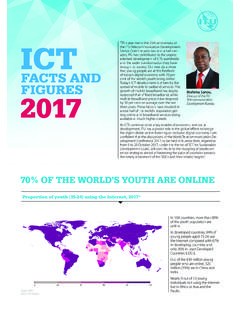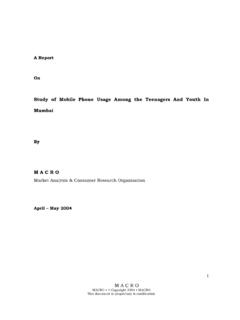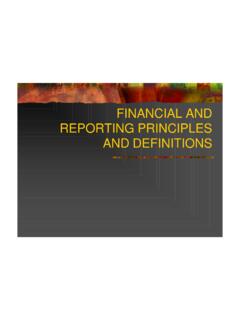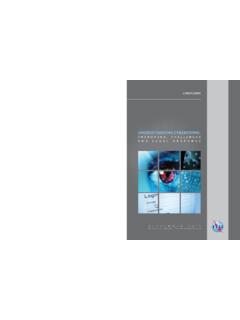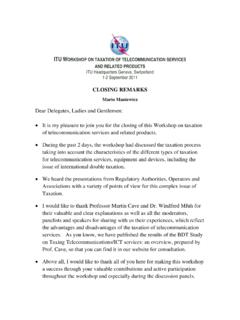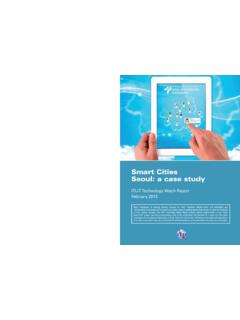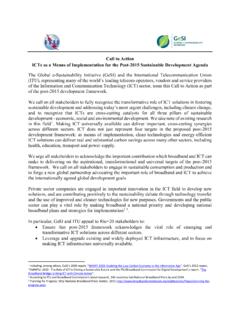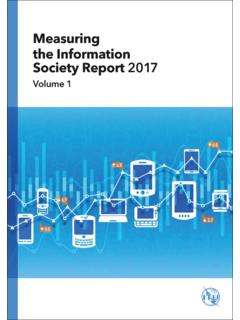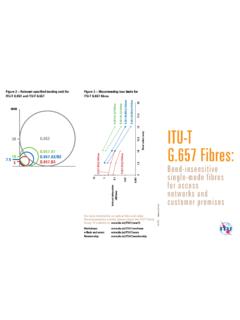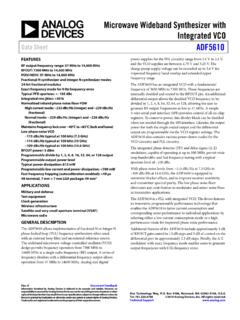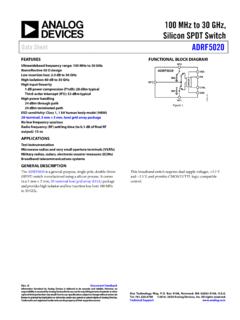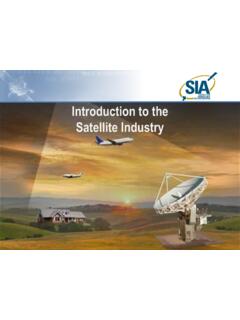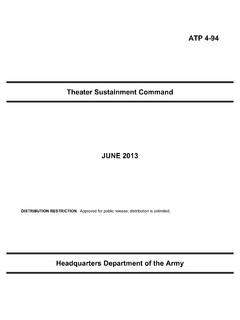Transcription of Use of very small aperture terminals (VSATs)
1 Report ITU-R (10/2013)Use of very small aperture terminals (VSATs) S SeriesFixed satellite service ii Rep. ITU-R Foreword The role of the Radiocommunication Sector is to ensure the rational, equitable, efficient and economical use of the radio-frequency spectrum by all radiocommunication services, including satellite services, and carry out studies without limit of frequency range on the basis of which Recommendations are adopted. The regulatory and policy functions of the Radiocommunication Sector are performed by World and Regional Radiocommunication Conferences and Radiocommunication Assemblies supported by Study Groups. Policy on Intellectual Property Right (IPR) ITU-R policy on IPR is described in the Common Patent Policy for ITU-T/ITU-R/ISO/IEC referenced in Annex 1 of Resolution ITU-R 1. Forms to be used for the submission of patent statements and licensing declarations by patent holders are available from where the Guidelines for Implementation of the Common Patent Policy for ITU-T/ITU-R/ISO/IEC and the ITU-R patent information database can also be found.
2 Series of ITU-R Reports (Also available online at ) Series Title BO Satellite delivery BR Recording for production, archival and play-out; film for television BS Broadcasting service (sound) BT Broadcasting service (television) F Fixed service M Mobile, radiodetermination, amateur and related satellite services P Radiowave propagation RA Radio astronomy RS Remote sensing systems S Fixed-satellite service SA Space applications and meteorology SF Frequency sharing and coordination between fixed-satellite and fixed service systems SM Spectrum management Note: This ITU-R Report was approved in English by the Study Group under the procedure detailed in Resolution ITU-R 1. Electronic Publication Geneva, 2014 ITU 2014 All rights reserved. No part of this publication may be reproduced, by any means whatsoever, without written permission of ITU. Rep. ITU-R 1 REPORT ITU-R Use of very small aperture terminals (VSATs) (2013) TABLE OF CONTENTS Page 1 Introduction.
3 2 2 Characteristics of VSATs .. 2 Overview .. 2 Operational characteristics of VSATs .. 2 Technical characteristics of VSATs .. 2 Antenna diameters .. 3 ITU-R Recommendations concerning technical and operational characteristics for VSATs .. 3 3 Topologies of networks with VSATs .. 7 Star type topology .. 7 Mesh type topology .. 8 Hybrid topology .. 9 Point-to-point topology .. 9 4 Features of operation of VSATs .. 10 Initialization of the operation of a vsat .. 10 Control and monitoring functions during the operation of a vsat .. 11 Other control and monitoring functions .. 12 Management of the profiles of VSATs (location, satellite beam contour and beam handover).
4 12 Dynamic power control function during the operation of a vsat .. 12 Adaptive coding and modulation function .. 13 5 Conclusion .. 14 2 Rep. ITU-R 1 Introduction This Report provides a normative base describing technical and operational characteristics for very small aperture terminals ( vsat ) networks. Among the topics included are features of vsat operation, vsat networks topologies, and control and monitoring functions. It is emphasized that VSATs, while in motion ( on board vessel, on land vehicle and on board aircraft), are not encompassed by this Report. 2 Characteristics of VSATs Overview VSATs could be described as earth stations that share satellite resources among a large number of similar terminals . Individual vsat terminals typically have small aperture sizes, transmit at relatively low equivalent isotropically radiated power ( ) levels, and use relatively small equipment that allows flexible installation of a satellite network earth station directly at a wide variety of user locations and platforms.
5 Technical and operational characteristics of VSATs are provided below. Operational characteristics of VSATs Some of the advantages of vsat operational characteristics are: local supervision of the terminal is not required; allows for efficient use of shared satellite resources; performance of the station is remotely monitored by a vsat network control centre; deployment in a geographical area without restrictions on installation density; so as to ensure the vsat is operating with the correct satellite and frequency, the vsat transmitter can only be enabled after having received authorization to do so via a signal from the vsat network control centre. As a consequence of these characteristics, many administrations around the world allow blanket licensing or simplified licensing procedures to allow quick deployment and easy operation of vsat networks. Technical characteristics of VSATs Technical characteristics of VSATs are: while most vsat networks make use of a star topology where a large hub is at the centre of the star which communicates with remotes, other topologies are possible (see 3); dynamic assignment of satellite capacity to accommodate variable demand by a vsat ; capability that allows compatibility with closely spaced satellites; capability of vsat to dynamically adapt to changing channel conditions in order to improve link reliability by manipulation of the station s characteristics such as signal parameters, data rate and power; typically designed so as to be able to carry TCP/IP traffic.
6 The vsat may also be designed to carry other multimedia applications; may make use of air interfaces appropriate for satellite communications (DVB-S2, DVB-RCS, etc.) which allow very diverse coding and modulation techniques corresponding to the most effective information technologies; Rep. ITU-R 3 typically operated in the 4/6 GHz, 11-12/14 GHz and 20/30 GHz frequency bands (see ); suitable for applications involving frequent relocation given the developments in control and monitoring functions. Antenna diameters VSATs are generally distinguished from the other types of earth stations by the use of smaller antenna apertures, which are nonetheless capable of operating with closely spaced satellites. They are most often designed to operate in the 6/4 GHz, 14/11-12 GHz and 30/20 GHz frequency bands.
7 The actual values of their antenna diameters might vary based on the standards of regional or national regulatory bodies (TIA, ETSI, etc.), satellite spacing and coordination agreements reached with adjacent satellite operators. NOTE For example, the ETSI standards EN 301 459 or EN 301 428 state that apertures for VSATs should not exceed m for the 14/11-12 GHz band and m for the 30/20 GHz band or corresponding equivalent diameters in case of non-circular apertures. In these cases, the equivalent diameter can be calculated using the equation in Recommendation ITU-R ITU-R Recommendations concerning technical and operational characteristics for VSATs VSATs should meet the technical and operational characteristics described in ITU-R Recommendations, summarized in Table 1. TABLE 1 ITU-R Recommendations for technical and operational characteristics of VSATs a) General technical and operational characteristics ITU-R Recommendations for VSATs ITU-R Recommendations for FSS earth stations including VSATs Comments This Recommendation defines that vsat technical parameters should comply with Recommendations ITU-R , ITU-R and ITU-R The monitoring and control functions of vsat networks should comply with Recommendation ITU-R This Recommendation proposes air interface characteristics which can be used as guidance for designers of broadband satellite networks (BSN) including summaries of TIA-1008-A, DVB-RCS (ETSI EN 301 790) and ETSI BSM/RSM-A.
8 Technical and operational requirements for vsat and USAT earth stations have been determined, including HDFSS, for global broadband Internet access (USAT ultra- small aperture terminal ). 4 Rep. ITU-R TABLE 1 (continued) ITU-R Recommendations for VSATs ITU-R Recommendations for FSS earth stations including VSATs Comments This Recommendation presents the technical characteristics of the existing and planned HDFSS networks. Technical characteristics are provided in the form of an EXCEL database for systems employing geostationary satellites. b) Antenna/Radio frequency characteristics ITU-R Recommendations for VSATs ITU-R Recommendations for FSS earth stations including VSATs Comments These Recommendations provide requirements for maximum permissible level of off-axis density: in any direction within 3 of the GSO in the 14 GHz band and for the cross-polarized component (Rec. ITU-R ); for or more off the main lobe axis of the earth station antenna in any direction within 3 of the GSO in the 6 GHz, 14 GHz and 30 GHz bands (Rec.
9 ITU-R ). For VSATs transmitting in the 14 GHz band, Recommendation ITU-R , which is 6 dB more rigid than Recommendation ITU-R , should be used. This Recommendation provides maximum permissible level of spurious emissions outside the band allocated to the FSS (Earth-to-space) within which the vsat operating frequency is assigned, such that the off-axis spurious from VSATs shall be below the provided limits for off axis angles greater than 7 , and inside the band allocated to the FSS (Earth-to-space) within which the vsat operating frequency is assigned. Rep. ITU-R 5 TABLE 1 (continued) ITU-R Recommendations for VSATs ITU-R Recommendations for FSS earth stations including VSATs Comments SМ.329 SМ.1540 SМ.328 These Recommendations provide requirements for unwanted emissions in the spurious domain and in the out-of-band domain. NOTE While applying Recommendations ITU-R and ITU-R , Recommendation ITU-R , which gives definitions, analytical models and other considerations of the values of emission components for various emission types as well as the usage of these values from the standpoint of spectrum efficiency, should be taken into account.
10 These Recommendations address requirements for a reference cross-polarized radiation pattern for the earth-station antenna. It may be useful for coordination studies and for the assessment of mutual interference between radiocommunication satellite systems and between earth stations of such systems and stations of other services sharing the same frequency band. For VSATs, Recommendation ITU-R should be used. (Note) These Recommendations provide reference radiation patterns for earth station antennas in the frequency range from 2 to 31 GHz which may be utilized for coordination and/or interference assessment between systems in the FSS. Recommendation ITU-R may be used for circular antennas while Recommendation ITU-R may be used both for circular and non-circular antennas. This Recommendation provides the design objectives of new symmetric aperture antennas such that the gain (G) of at least 90% of the side-lobe peaks does not exceed the provided limits.
